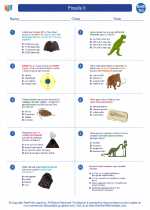Altitude in Earth Science
Altitude refers to the height of an object or point in relation to a specific reference point, such as sea level or the Earth's surface. In the context of Earth science, altitude is often used to describe the elevation of features on the Earth's surface, such as mountains, valleys, and plateaus. It is an important concept in understanding the topography and geography of the Earth.
Types of Altitude
There are several types of altitude that are commonly used in Earth science:
- Elevation: The height of an object or point above a specific reference point, often measured in terms of its distance above sea level.
- True Altitude: The vertical distance of an object above sea level.
- Geopotential Height: The height of a pressure surface in the atmosphere above sea level.
- Topographic Altitude: The height of a point on the Earth's surface above a reference geoid, which represents the shape that the Earth's oceans would take under the influence of gravity and rotation alone.
Factors Affecting Altitude
The altitude of a location is influenced by various factors, including:
- Geological Processes: Tectonic activity, volcanic eruptions, and erosion can all contribute to changes in altitude over time.
- Climate and Weather: Atmospheric conditions and weather patterns can affect the altitude of a region through processes such as erosion, glacier formation, and deposition of sediments.
- Human Activity: Human activities such as mining, construction, and land use changes can also alter the altitude of a location.
Studying Altitude
To study altitude in Earth science, it is important to understand concepts such as topographic maps, contour lines, and satellite-based elevation data. Additionally, knowledge of geological processes, climate patterns, and human impact on the environment is crucial in comprehending the factors that influence altitude changes over time.
Study Guide
Here are some key points to focus on when studying altitude in Earth science:
- Understand the different types of altitude and how they are measured.
- Learn about the factors that influence changes in altitude over time.
- Practice reading and interpreting topographic maps and contour lines to understand elevation changes in a given area.
- Explore the use of satellite imagery and digital elevation models to study altitude at a global scale.
- Consider the impact of human activities on the altitude of specific regions.
By mastering these concepts and skills, you will gain a deeper understanding of altitude and its significance in Earth science.
.


